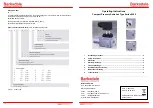
13-10
z
RFC 2463: Internet Control Message Protocol (ICMPv6) for the Internet Protocol Version 6 (IPv6)
Specification
z
RFC 2464: Transmission of IPv6 Packets over Ethernet Networks
z
RFC 2526: Reserved IPv6 Subnet Anycast Addresses
z
RFC 3307: Allocation Guidelines for IPv6 Multicast Addresses
z
RFC 3513: Internet Protocol Version 6 (IPv6) Addressing Architecture
z
RFC 3596: DNS Extensions to Support IP Version 6
IPv6 Basics Configuration Task List
Complete the following tasks to perform IPv6 basics configuration:
Task
Remarks
Configuring Basic IPv6 Functions
Required
Configuring IPv6 NDP
Optional
Configuring PMTU Discovery
Optional
Configuring IPv6 TCP Properties
Optional
Configuring ICMPv6 Packet Sending
Optional
Configuring IPv6 DNS Client
Optional
Configuring Basic IPv6 Functions
Enabling IPv6
Before performing IPv6-related configurations, you need to Enable IPv6. Otherwise, an interface
cannot forward IPv6 packets even if it has an IPv6 address configured.
Follow these steps to Enable IPv6:
To do...
Use the command...
Remarks
Enter system view
system-view
—
Enable IPv6
ipv6
Required
Disabled by default.
Configuring an IPv6 Unicast Address
IPv6 site-local addresses and aggregatable global unicast addresses can be configured in the
following ways:
z
EUI-64 format: When the EUI-64 format is adopted, the IPv6 address prefix of an interface is the
configured prefix, and the interface identifier is derived from the link-layer address of the interface.
z
Manual configuration: IPv6 site-local addresses or aggregatable global unicast addresses are
configured manually.
IPv6 link-local addresses can be configured in either of the following ways:
z
Automatic generation: The device automatically generates a link-local address for an interface
according to the link-local address prefix (FE80::/10) and the link-layer address of the interface.
















































